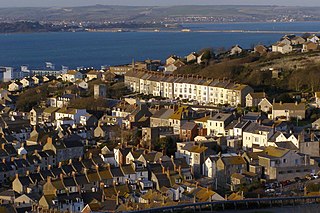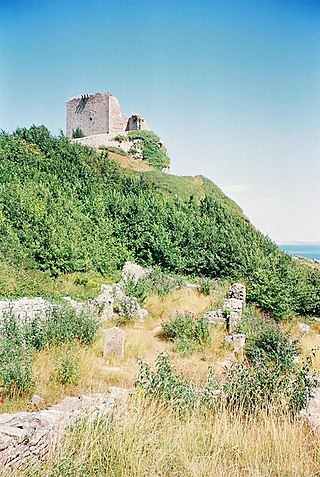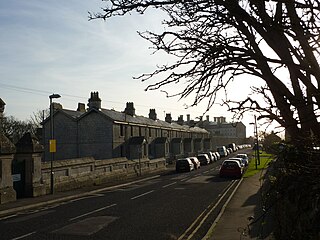
Portland Harbour is located beside the Isle of Portland, Dorset, on the south coast of England. Construction of the harbour began in 1849; when completed in 1872, its 520-hectare (1,300-acre) surface area made it the largest human-made harbour in the world, and it remains one of the largest in the world today. It is naturally sheltered by Portland to the south, Chesil Beach to the west and mainland Dorset to the north. It consists of four breakwaters: two southern and two northern. These have a total length of 4.57 km (2.84 mi) and enclose approximately 1,000 ha of water.

Portland Bill is a narrow promontory at the southern end of the Isle of Portland, and the southernmost point of Dorset, England. One of Portland's most popular destinations is Portland Bill Lighthouse. Portland's coast has been notorious for the number of shipwrecked vessels over the centuries. The dangerous coastline features shallow reefs and the Shambles sandbank, made more hazardous due to the strong Portland tidal race.

Fortuneswell is a village in Underhill on the Isle of Portland, in Dorset, England. It lies on steeply sloping land on the northern edge of the island, known as Underhill, where Chesil Beach connects the island to the mainland. Adjoining Fortuneswell are Chiswell to the west and Castletown to the north. Fortuneswell occupies the steeper land above sea level, whereas Chiswell and Castletown occupy flat land close to sea level, next to Chesil Beach and Portland Harbour respectively. Fortuneswell has a main shopping street, and along with Easton, is the main hub of the island's activities.

Easton is a village on the Isle of Portland in Dorset, England. The village is situated at Tophill, within the centre of the island. As with the rest of Portland's villages and settlements, Easton, including the settlements Reforne and Straits, has been designated as a conservation area, as it is a place of special architectural and historic interest. Easton, Wakeham and Reforne were designated pre-1974.

The Verne High Angle Battery is a former 19th-century gun battery on the Isle of Portland in Dorset, England. Situated close to the Verne Citadel, the battery is Grade II Listed, and forms part of the citadel's scheduled monument status. The battery has become a tourist attraction, while the battery's tunnels are often referred to by their local name 'Ghost Tunnels'.

Wakeham is a hamlet near the village of Easton, in Tophill on the Isle of Portland in Dorset, England. It is situated between the Straits part of Easton, and Pennsylvania Castle. As with the rest of Portland's villages and settlements, Wakeham has been designated as a conservation area, as it is a place of special architectural and historic interest. Easton, Wakeham and Reforne were designated pre-1974. The hamlet features a distinctively wide road running through it, once built to allow space for horse-drawn carts transporting stone by road. Many of Wakeham's older buildings of the 17th and 18th century survive.
Weston is a village in Tophill on the Isle of Portland, Dorset, England. It abuts the main village Easton. As with the rest of Portland's villages and settlements, Weston has been designated as a conservation area, as it is a place of special architectural and historic interest. The village was designated in 1994.

Caston Tower Windmill is a grade II* listed tower mill at Caston, Norfolk, England which is under restoration. The mill is also a scheduled monument.

Rufus Castle, also known as Bow and Arrow Castle, is a partially ruined castle overlooking Church Ope Cove on Portland, England. Its name derives from King William II, known as William Rufus, for whom the original castle was built.

The Grove is a small village located at Tophill on the Isle of Portland in Dorset. The village is found close to the larger village Easton, and is most notable for containing the HM Prison Portland, including its museum Grove Prison Museum. As with the rest of Portland's villages and settlements, The Grove has been designated as a conservation area, as it is a place of special architectural and historic interest. The village was designated in 1981.

St Andrew's Church is a ruined church located above Church Ope Cove on the Isle of Portland, Dorset, England. St Andrew's was Portland's first parish church and remained as such until the mid-18th century. It is now one of the island's prime historical sites, and is a Grade II* Listed Building and a Scheduled Monument. The southern retaining wall of the churchyard is also Grade II Listed, as are three remaining churchyard monuments, approximately 7 metres south of the church.

St. Peter's Church is a former Church of England church in The Grove, on the Isle of Portland, Dorset. Designed by Major-General Sir Edmund Du Cane, the church was built in 1870-72 and is now a Grade II* Listed building. The gate piers and boundary walls to the north and west of the church are also Grade II Listed, along with the church's vicarage. St. Peter's Church is included on Historic England's "Heritage at Risk" register.

Easton Gardens is a public garden, located at Tophill, Isle of Portland, Dorset, England. It is found at Easton Square, the centre of Easton village. The gardens have remained a focal point since their opening in 1904 and have been awarded the Green Flag Award in recent years. The gardens feature grassed and formal bedding areas, with other facilities including a children's play area and basketball court.

St George's Centre is a former school, built in the 19th century, and now a community information and activity centre on the Isle of Portland, Dorset, England. It is located in the area of Reforne, near the village of Easton. Both the centre and its community hall, which was formerly the school assembly hall, have been a Grade II listed since 1978.

Culverwell Mesolithic Site is a Mesolithic settlement, located on the Isle of Portland, Dorset, England. It is found in the local area known as Culverwell, along the Portland Bill Road. It is within an area of unspoiled countryside, with no past quarrying. The site is maintained by the Association for Portland Archaeology – a small group dedicated to researching, investigating and excavating on Portland.

Grove Lime Kiln is a disused 19th century lime kiln on the Isle of Portland, Dorset, England. It is located close to HM Prison Portland and The Grove village. Owned by the prison service, the lime kiln has been Grade II Listed since 2009.

All Saints Church is a Church of England church in Easton, on the Isle of Portland, Dorset. It was consecrated in 1917 and has been a listed grade II building since September 1978. The church succeeded to the rights, privileges, registers and silver of the St George's Church. It has been described as the finest ecclesiastical building on Portland – though somewhat hidden at its position. The church remains active to date, as part of the Portland Parish – a host of three churches; St. John's Church, All Saints Church and the Avalanche Memorial Church.

St. John's Church is an Anglican Church of England church in Fortuneswell, on the Isle of Portland, Dorset. It was built between 1838–40 and has been a Listed Grade II building since January 1951. The churchyard walls, gate piers, railings, and steps of St. John's Church, dating from 1839–40, became Grade II Listed in September 1978. At this same time, two headstone monuments, about 5 metres north east from the west tower of the church became Grade II Listed.

Easton Methodist Church is a Methodist Church in Easton, on the Isle of Portland, Dorset, which was built in 1906–07. The church, along with its former manse and boundary walls, has been a Grade II* Listed since May 1993. Its church hall was formerly a Wesleyan school, dated 1878 on the porch. The school, with the boundary wall, was designated Grade II in May 1993. The church remains active to date, as part of the Portland Methodist Circuit – which involves two churches; Underhill Methodist Church and Easton Methodist Church.


















